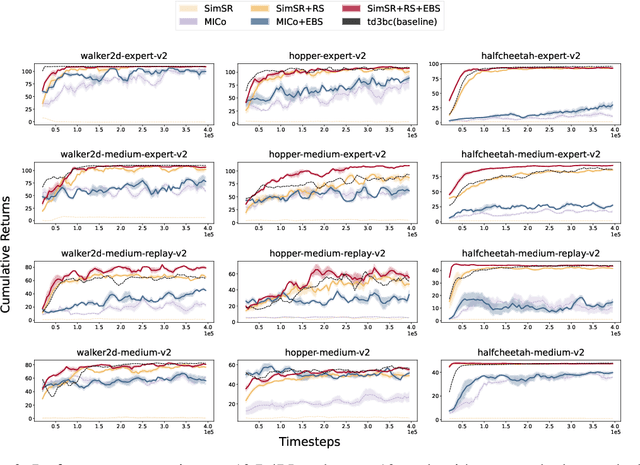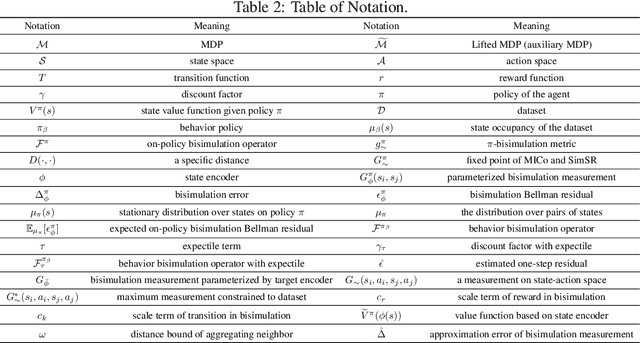Riashat Islam
Next-Latent Prediction Transformers Learn Compact World Models
Nov 08, 2025Abstract:Transformers replace recurrence with a memory that grows with sequence length and self-attention that enables ad-hoc look ups over past tokens. Consequently, they lack an inherent incentive to compress history into compact latent states with consistent transition rules. This often leads to learning solutions that generalize poorly. We introduce Next-Latent Prediction (NextLat), which extends standard next-token training with self-supervised predictions in the latent space. Specifically, NextLat trains a transformer to learn latent representations that are predictive of its next latent state given the next output token. Theoretically, we show that these latents provably converge to belief states, compressed information of the history necessary to predict the future. This simple auxiliary objective also injects a recurrent inductive bias into transformers, while leaving their architecture, parallel training, and inference unchanged. NextLat effectively encourages the transformer to form compact internal world models with its own belief states and transition dynamics -- a crucial property absent in standard next-token prediction transformers. Empirically, across benchmarks targeting core sequence modeling competencies -- world modeling, reasoning, planning, and language modeling -- NextLat demonstrates significant gains over standard next-token training in downstream accuracy, representation compression, and lookahead planning. NextLat stands as a simple and efficient paradigm for shaping transformer representations toward stronger generalization.
h1: Bootstrapping LLMs to Reason over Longer Horizons via Reinforcement Learning
Oct 08, 2025Abstract:Large language models excel at short-horizon reasoning tasks, but performance drops as reasoning horizon lengths increase. Existing approaches to combat this rely on inference-time scaffolding or costly step-level supervision, neither of which scales easily. In this work, we introduce a scalable method to bootstrap long-horizon reasoning capabilities using only existing, abundant short-horizon data. Our approach synthetically composes simple problems into complex, multi-step dependency chains of arbitrary length. We train models on this data using outcome-only rewards under a curriculum that automatically increases in complexity, allowing RL training to be scaled much further without saturating. Empirically, our method generalizes remarkably well: curriculum training on composed 6th-grade level math problems (GSM8K) boosts accuracy on longer, competition-level benchmarks (GSM-Symbolic, MATH-500, AIME) by up to 2.06x. Importantly, our long-horizon improvements are significantly higher than baselines even at high pass@k, showing that models can learn new reasoning paths under RL. Theoretically, we show that curriculum RL with outcome rewards achieves an exponential improvement in sample complexity over full-horizon training, providing training signal comparable to dense supervision. h1 therefore introduces an efficient path towards scaling RL for long-horizon problems using only existing data.
Wavelet Predictive Representations for Non-Stationary Reinforcement Learning
Oct 06, 2025Abstract:The real world is inherently non-stationary, with ever-changing factors, such as weather conditions and traffic flows, making it challenging for agents to adapt to varying environmental dynamics. Non-Stationary Reinforcement Learning (NSRL) addresses this challenge by training agents to adapt rapidly to sequences of distinct Markov Decision Processes (MDPs). However, existing NSRL approaches often focus on tasks with regularly evolving patterns, leading to limited adaptability in highly dynamic settings. Inspired by the success of Wavelet analysis in time series modeling, specifically its ability to capture signal trends at multiple scales, we propose WISDOM to leverage wavelet-domain predictive task representations to enhance NSRL. WISDOM captures these multi-scale features in evolving MDP sequences by transforming task representation sequences into the wavelet domain, where wavelet coefficients represent both global trends and fine-grained variations of non-stationary changes. In addition to the auto-regressive modeling commonly employed in time series forecasting, we devise a wavelet temporal difference (TD) update operator to enhance tracking and prediction of MDP evolution. We theoretically prove the convergence of this operator and demonstrate policy improvement with wavelet task representations. Experiments on diverse benchmarks show that WISDOM significantly outperforms existing baselines in both sample efficiency and asymptotic performance, demonstrating its remarkable adaptability in complex environments characterized by non-stationary and stochastically evolving tasks.
Learning Fused State Representations for Control from Multi-View Observations
Feb 03, 2025



Abstract:Multi-View Reinforcement Learning (MVRL) seeks to provide agents with multi-view observations, enabling them to perceive environment with greater effectiveness and precision. Recent advancements in MVRL focus on extracting latent representations from multiview observations and leveraging them in control tasks. However, it is not straightforward to learn compact and task-relevant representations, particularly in the presence of redundancy, distracting information, or missing views. In this paper, we propose Multi-view Fusion State for Control (MFSC), firstly incorporating bisimulation metric learning into MVRL to learn task-relevant representations. Furthermore, we propose a multiview-based mask and latent reconstruction auxiliary task that exploits shared information across views and improves MFSC's robustness in missing views by introducing a mask token. Extensive experimental results demonstrate that our method outperforms existing approaches in MVRL tasks. Even in more realistic scenarios with interference or missing views, MFSC consistently maintains high performance.
Reinforcement Learning for Sequence Design Leveraging Protein Language Models
Jul 03, 2024



Abstract:Protein sequence design, determined by amino acid sequences, are essential to protein engineering problems in drug discovery. Prior approaches have resorted to evolutionary strategies or Monte-Carlo methods for protein design, but often fail to exploit the structure of the combinatorial search space, to generalize to unseen sequences. In the context of discrete black box optimization over large search spaces, learning a mutation policy to generate novel sequences with reinforcement learning is appealing. Recent advances in protein language models (PLMs) trained on large corpora of protein sequences offer a potential solution to this problem by scoring proteins according to their biological plausibility (such as the TM-score). In this work, we propose to use PLMs as a reward function to generate new sequences. Yet the PLM can be computationally expensive to query due to its large size. To this end, we propose an alternative paradigm where optimization can be performed on scores from a smaller proxy model that is periodically finetuned, jointly while learning the mutation policy. We perform extensive experiments on various sequence lengths to benchmark RL-based approaches, and provide comprehensive evaluations along biological plausibility and diversity of the protein. Our experimental results include favorable evaluations of the proposed sequences, along with high diversity scores, demonstrating that RL is a strong candidate for biological sequence design. Finally, we provide a modular open source implementation can be easily integrated in most RL training loops, with support for replacing the reward model with other PLMs, to spur further research in this domain. The code for all experiments is provided in the supplementary material.
Sequence-Augmented SE(3)-Flow Matching For Conditional Protein Backbone Generation
May 30, 2024Abstract:Proteins are essential for almost all biological processes and derive their diverse functions from complex 3D structures, which are in turn determined by their amino acid sequences. In this paper, we exploit the rich biological inductive bias of amino acid sequences and introduce FoldFlow-2, a novel sequence-conditioned SE(3)-equivariant flow matching model for protein structure generation. FoldFlow-2 presents substantial new architectural features over the previous FoldFlow family of models including a protein large language model to encode sequence, a new multi-modal fusion trunk that combines structure and sequence representations, and a geometric transformer based decoder. To increase diversity and novelty of generated samples -- crucial for de-novo drug design -- we train FoldFlow-2 at scale on a new dataset that is an order of magnitude larger than PDB datasets of prior works, containing both known proteins in PDB and high-quality synthetic structures achieved through filtering. We further demonstrate the ability to align FoldFlow-2 to arbitrary rewards, e.g. increasing secondary structures diversity, by introducing a Reinforced Finetuning (ReFT) objective. We empirically observe that FoldFlow-2 outperforms previous state-of-the-art protein structure-based generative models, improving over RFDiffusion in terms of unconditional generation across all metrics including designability, diversity, and novelty across all protein lengths, as well as exhibiting generalization on the task of equilibrium conformation sampling. Finally, we demonstrate that a fine-tuned FoldFlow-2 makes progress on challenging conditional design tasks such as designing scaffolds for the VHH nanobody.
Learning Latent Dynamic Robust Representations for World Models
May 10, 2024Abstract:Visual Model-Based Reinforcement Learning (MBRL) promises to encapsulate agent's knowledge about the underlying dynamics of the environment, enabling learning a world model as a useful planner. However, top MBRL agents such as Dreamer often struggle with visual pixel-based inputs in the presence of exogenous or irrelevant noise in the observation space, due to failure to capture task-specific features while filtering out irrelevant spatio-temporal details. To tackle this problem, we apply a spatio-temporal masking strategy, a bisimulation principle, combined with latent reconstruction, to capture endogenous task-specific aspects of the environment for world models, effectively eliminating non-essential information. Joint training of representations, dynamics, and policy often leads to instabilities. To further address this issue, we develop a Hybrid Recurrent State-Space Model (HRSSM) structure, enhancing state representation robustness for effective policy learning. Our empirical evaluation demonstrates significant performance improvements over existing methods in a range of visually complex control tasks such as Maniskill \cite{gu2023maniskill2} with exogenous distractors from the Matterport environment. Our code is avaliable at https://github.com/bit1029public/HRSSM.
Generalizing Multi-Step Inverse Models for Representation Learning to Finite-Memory POMDPs
Apr 22, 2024Abstract:Discovering an informative, or agent-centric, state representation that encodes only the relevant information while discarding the irrelevant is a key challenge towards scaling reinforcement learning algorithms and efficiently applying them to downstream tasks. Prior works studied this problem in high-dimensional Markovian environments, when the current observation may be a complex object but is sufficient to decode the informative state. In this work, we consider the problem of discovering the agent-centric state in the more challenging high-dimensional non-Markovian setting, when the state can be decoded from a sequence of past observations. We establish that generalized inverse models can be adapted for learning agent-centric state representation for this task. Our results include asymptotic theory in the deterministic dynamics setting as well as counter-examples for alternative intuitive algorithms. We complement these findings with a thorough empirical study on the agent-centric state discovery abilities of the different alternatives we put forward. Particularly notable is our analysis of past actions, where we show that these can be a double-edged sword: making the algorithms more successful when used correctly and causing dramatic failure when used incorrectly.
PcLast: Discovering Plannable Continuous Latent States
Nov 06, 2023



Abstract:Goal-conditioned planning benefits from learned low-dimensional representations of rich, high-dimensional observations. While compact latent representations, typically learned from variational autoencoders or inverse dynamics, enable goal-conditioned planning they ignore state affordances, thus hampering their sample-efficient planning capabilities. In this paper, we learn a representation that associates reachable states together for effective onward planning. We first learn a latent representation with multi-step inverse dynamics (to remove distracting information); and then transform this representation to associate reachable states together in $\ell_2$ space. Our proposals are rigorously tested in various simulation testbeds. Numerical results in reward-based and reward-free settings show significant improvements in sampling efficiency, and yields layered state abstractions that enable computationally efficient hierarchical planning.
Understanding and Addressing the Pitfalls of Bisimulation-based Representations in Offline Reinforcement Learning
Oct 26, 2023



Abstract:While bisimulation-based approaches hold promise for learning robust state representations for Reinforcement Learning (RL) tasks, their efficacy in offline RL tasks has not been up to par. In some instances, their performance has even significantly underperformed alternative methods. We aim to understand why bisimulation methods succeed in online settings, but falter in offline tasks. Our analysis reveals that missing transitions in the dataset are particularly harmful to the bisimulation principle, leading to ineffective estimation. We also shed light on the critical role of reward scaling in bounding the scale of bisimulation measurements and of the value error they induce. Based on these findings, we propose to apply the expectile operator for representation learning to our offline RL setting, which helps to prevent overfitting to incomplete data. Meanwhile, by introducing an appropriate reward scaling strategy, we avoid the risk of feature collapse in representation space. We implement these recommendations on two state-of-the-art bisimulation-based algorithms, MICo and SimSR, and demonstrate performance gains on two benchmark suites: D4RL and Visual D4RL. Codes are provided at \url{https://github.com/zanghyu/Offline_Bisimulation}.
 Add to Chrome
Add to Chrome Add to Firefox
Add to Firefox Add to Edge
Add to Edge